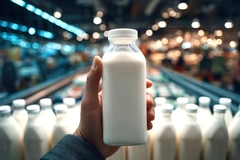Tray circularity: Tomra Recycling talks cross-industry dipping challenges
 Valerio Sama, business development manager for packaging at Tomra Recycling (All image credits: Tomra Recycling).
Valerio Sama, business development manager for packaging at Tomra Recycling (All image credits: Tomra Recycling).The recycled content in PET-based food trays typically comes from beverage bottles, diverting feedstock away from a closed-loop bottle recycling system, according to Tomra Recycling. But the company says that today, R&D has made tray-to-tray recycling a technologically and economically feasible option.
Packaging Insights speaks to Valerio Sama, business development manager for packaging at Tomra Recycling, about the challenges with tray-to-tray recycling and emerging solutions. These include Tomra Recycling’s Autosort system that can differentiate between monolayer and multilayer PET trays, and Innosort Flake and Autosort Flake which further refine the stream.
Sama says the material complexity of trays poses a challenge. “Many PET trays are made from multilayer structures [PET/PE or PET/barrier coatings] which are not compatible with existing recycling streams.”
He notes that sorting can also bring difficulty, particularly “the separation of food and non-food trays to incorporate recycled content back into food trays.”
Another challenge he identifies is the quality of recyclate. “Even when recycled, tray-derived PET often contains additives, colors or contamination that limit its reuse in food packaging.”
Potential solutions, according to Sama, are simplifying to monomaterial PET trays as much as possible, and improving sorting technologies, including advanced near-infrared (NIR), AI-deep learning.
He also calls for the establishment of design-for-recycling guidelines and aligning industry standards, and increasing demand pull by setting minimum recycled-content targets for trays, such as through the EU’s Packaging and Packaging Waste Regulation.
Current tray recycling practices
 PET trays’ complex designs and composition present a major hurdle during sorting.Sama explains that, in practice, most PET trays collected today are downcycled into non-food applications, such as strapping, thermoforms for non-food, and textiles.
PET trays’ complex designs and composition present a major hurdle during sorting.Sama explains that, in practice, most PET trays collected today are downcycled into non-food applications, such as strapping, thermoforms for non-food, and textiles.
“True tray-to-tray recycling is still very limited, partly because of technical challenges and food-contact safety approvals.”
According to Tomra Recycling, sensor-based sorting systems can now enable high-quality recovery of PET trays. Its NIR multifunctional Autosort system differentiates between monolayer and multilayer PET, which is essential because only monolayer trays can be used for high-quality, closed-loop recycling.
Sorting technologies at the flake level are said to be utilized to address a range of contaminants. Machines with multi-sensor configurations are able to detect flakes by polymer type, color, transparency, and material aging at the same time. This precision is needed to remove substances such as PVC, metals, and opaque particles.
After the trays are shredded into flakes, Tomra Recycling’s Innosort Flake system separates materials based on polymer type, color, and transparency. It then separates contaminants such as opaque PET, PVC, and PC while minimizing material loss.
The Autostort Flake refines the flake stream further, as it is capable of detecting metals and multilayers using multifaceted sorting technologies. It is said to handle complex impurities that could otherwise degrade quality.
Tomra Recycling’s sorting stages are a tool for manufacturers to meet the current requirements of food-contact packaging.
“A systemic change is needed, including better design, investment in recycling technology, and regulatory pressure — all of which must come together,” Sama continues.
“Innovation in emerging technologies [advanced mechanical recycling, improved sorting, barrier coatings] may unlock higher recycling rates for trays in the near future. Without aligning on recyclability standards, trays risk becoming the ‘problem child’ of PET packaging, undermining circularity goals.”
Learning from DRS success
 Tomra Recycling’s flake-level sorting targets make tray-to-tray recycling possible.Sama says the lack of appropriate collection infrastructure remains a major bottleneck for tray recycling.
Tomra Recycling’s flake-level sorting targets make tray-to-tray recycling possible.Sama says the lack of appropriate collection infrastructure remains a major bottleneck for tray recycling.
“While PET bottles benefit from well-established DRS and high collection rates, trays are often collected with mixed packaging or not at all,” he argues.
“Just as plastic bottles have transitioned to a few standardised formats — with clear or light blue PET, consistent caps and uniform labels — plastic trays could similarly shift toward a small, universally recyclable set of designs.
He adds that mandating recyclability criteria and recycled-content quotas has been successful for bottles and could also drive tray recycling.
“The alignment across the value between brand owners, recyclers, and policymakers in bottles needs to be replicated for trays. Trays can be made more recyclable through standardisation on clear mono-PET and avoiding problematic labels, colors, and adhesives.”
Sama says a DRS is unlikely to solve tray recycling challenges, as it is “less practical” than for bottles because trays are bulkier and more contaminated (due to food residues).
“However, implementation of EPR schemes or targeted collection incentives could help improve recovery rates, as well as the modernisation of existing sorting facilities.”
Discussing if multilayer trays should be banned outright due to the many issues associated with their recycling, Sama says that this might not be the best solution, as multilayer trays often provide shelf life and safety benefits.
“However, restricting their use to applications where absolutely necessary and encouraging alternatives would be a balanced approach. Regulatory frameworks could progressively phase out non-recyclable formats rather than impose an immediate ban.”











